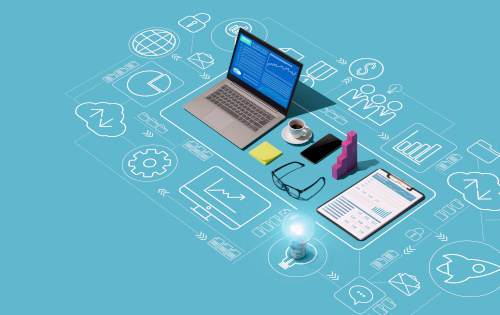Network monitoring tools track network device availability and bandwidth use to detect bottlenecks and anomalous activity. Network monitoring tools also monitor DNS, SQL, mail, FTP, and virtual server uptime, identifying the cause of any downtime or other network performance issues. Lastly, they can be used to filter web content, monitor internet surfing activities, and view your website’s availability.
Endpoint Management
Endpoint management tools provide real-time visibility into the various devices that have access to your network, allowing you to deploy patches, perform maintenance, and run virus scans.
There are two main types of endpoint management tools: United Endpoint Management (UEM) and Remote Monitoring and Management (RMM). The former centralizes security, patching, and performance monitoring for all mobile and desktop devices. The latter remotely gathers data on endpoints and allows admins to carry out tasks, scripts, and patching remotely.
IT workers can use a multi-platform endpoint management system to manage all devices from a single programmable panel, providing essential features such as patch management and threat detection.
Endpoint management has become crucial for school districts in recent years. Just like their business counterparts, most districts provide devices to their staff and faculty. Further, district and school tech teams that have rolled out 1:1 programs for students are managing exponentially more devices (or, in this context, endpoints) than they ever have in the past.
Identity and Access Authentication
Identity and access authentication tools help streamline the management of user accounts, including access privileges or permissions. These determine which resources individual accounts, groups, and organizational units can access in your information infrastructure.
Key features of this authentication include a database of user identities and their access privileges, tools for granting, monitoring, editing, and revoking privileges, as well as audit logging of access history.
Commonly-used identity and access authentication methods in education include multi-factor authentication (MFA) and single sign-on (SSO).
For a long time, education leaders were resistant to MFA controls. However, it is considered to be among the most simple and effective control against cybercriminal attacks, including ransomware. In fact, beginning in 2021, most cyber insurance providers serving education now require MFA controls for coverage. Without it, premiums increase significantly. That change alone has had the most influence on ending the MFA debate in education.
Cloud Security
Technically, your cloud domain is outside of your network perimeter. However, cloud security is critical to include on this list because a common misconception is that network management and security tools are sufficient to protect data and user accounts in the cloud.
Most K-12 school districts use at least one of the big cloud tech companies such as Google Workspace, Microsoft 365, Zoom, or AWS. Further, 90 percent of school districts are using cloud applications for various purposes beyond classroom learning, such as human resources and financial information.
Cloud security protects a district’s data stored in the cloud by preventing unauthorized access,
quarantining malware and phishing, and automating data loss prevention from malicious and accidental exposure. When selecting the right cloud security tool, IT professionals should look for centralized visibility, control of cloud domains, and data loss prevention automation. You should also look for a tool that provides the ability to customize configuration because no two districts are identical.
“Defense-in-depth” is an important concept in cybersecurity that advocates for a multi-layered approach to protect, detect, and respond to risks. This combination of tools should provide the framework for an IT director at a school to protect all relevant stakeholders. But having a strategy about how to use them is also vital. Schools must have replacement cycles so, when security technology and network equipment expires, the updates are planned for in advance and have funding allocated. Lastly, benchmarks and goals for these systems give staff a great overview. For example, built-in dashboards can provide metrics that inform tech admins as to whether incidents are spiking, the types of incidents that are occurring, or whether they need to try a different set of tools.
- Are substitutes the answer to the teacher shortage? - June 13, 2023
- Preparing for ransomware attacks begins with education - June 13, 2023
- How to use UDL-inspired technology to reengage students - June 12, 2023

